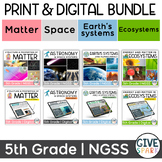5th Grade Matter PRINT AND DIGITAL bundle - NGSS Science Complete Unit
- Zip
What educators are saying
Products in this Bundle (2)
Also included in
- Fifth Grade NGSS: The Ultimate Teaching Bundle – Print & Digital!Get ready for an exciting teaching journey with this all-in-one bundle, perfect for fifth-grade teachers. This package features four highly engaging science units, meticulously aligned with the Next Generation Science Standards (NGPrice $90.00Original Price $119.80Save $29.80
Description
5th Grade Matter PRINT AND DIGITAL Bundle, NGSS Science Unit
This comprehensive teaching unit is specifically designed for fifth-grade students to learn about the topic of matter.
Standards Alignment:
The unit consists of 12 engaging lessons that incorporate hands-on activities. It is fully aligned with the Next Generation Science Standards (NGSS) for fifth grade, specifically covering standards 5-PS1-1, 5-PS1-2, 5-PS1-3, and 5-PS1-4.
PRINT AND DIGITAL FORMATS:
Enjoy flexibility, with all activities available in both print and digital versions. The digital version is hosted on Google Slides and comes with options such as narrated audio lessons, video science lab demonstrations, and other activities allowing for easier differentiation and self-paced student learning.
APPROACH TO LEARNING
Unlock your students' natural curiosity and passion for science with this interactive and hands-on teaching unit. Designed to connect with their prior knowledge and provide immersive experiences, this unit offers lessons that guide students through complex scientific principles in an accessible way. Students will actively participate in hands-on experiments and activities that make learning exciting and memorable. This unit promotes independent learning and encourages students to reflect on their understanding, helping them build a solid foundation of knowledge in a fun and stimulating environment.
WHAT'S COVERED?
In this unit, we look at the following topics:
- Lesson 1 - What is matter?
- Lesson 2 - What is matter made of?
- Lesson 3 - Why does matter exist in different states?
- Lesson 4 - How does one type of matter change? (Changing State)
- Lesson 5 - How can we describe and classify matter?
- Lesson 6 - What are the properties of metals?
- Lesson 7 - Properties of Matter: Solubility
- Lesson 8 - What happens when matter dissolves?
- Lesson 9 - What is the difference between a physical and chemical change?
- Lesson 10 - How do we know a chemical reaction has occurred?
- Lesson 11 - Does the amount of matter change during a chemical change?
- Lesson 12 - Identifying an unknown substance using its properties.
Key Features:
- Printable Resources: Detailed lesson plans, student response journals, assessments, quizzes, hands-on investigations, science lab activities, vocabulary posters, guiding questions, an end-of-unit project, and much more. Everything you need in a tangible, ready-to-use format
- Digital Resources on Google Slides: Each lesson comes in a digital variant enriched with narrated audio slides. This ensures that students can engage with content at their own pace, making it particularly useful for remote learning, differentiated instruction, or for students who benefit from auditory learning. Interactive activities incorporated within these slides further enhance student engagement and understanding. All labs have a video demonstration version to allow for flexibility between in-person labs and digital labs.
For a more in-depth look at each component, please visit the individual product descriptions.
NEED HELP? Before leaving feedback:
- Email me at givesparkco@gmail.com
- submit a help ticket
- ask a question on the Q& A tab
Thanks for stopping by x
Vicky
TERMS OF USE - © Give Spark, Inc.™
This item is a paid digital download from my TpT store.As such, it is for use in one classroom only. This item is also bound by copyright laws. Redistributing, editing, selling, or posting this item (or any part thereof) on the Internet are all strictly prohibited without first gaining permission from the author. Violations are subject to the penalties of the Digital Millennium Copyright Act. Please contact me if you wish to be granted special permissions.





